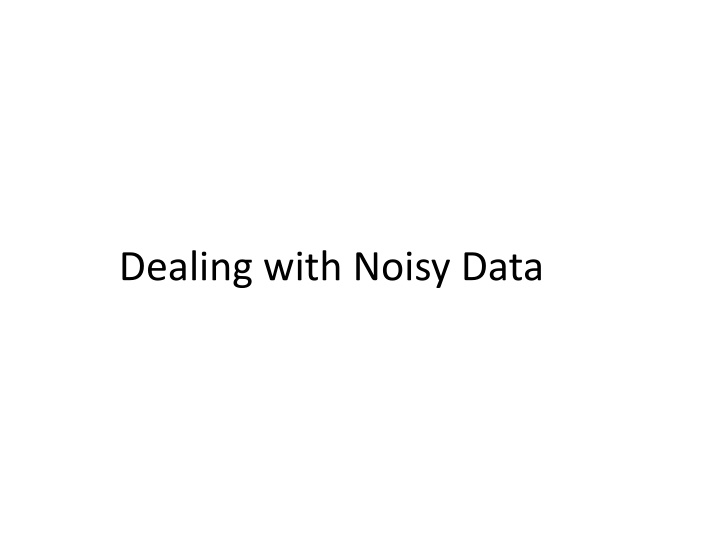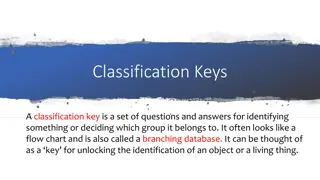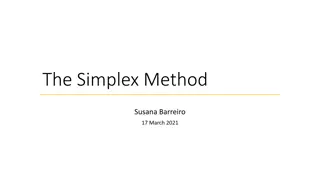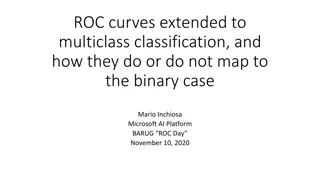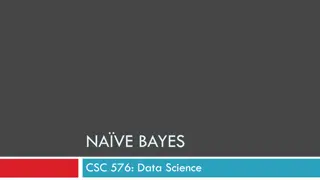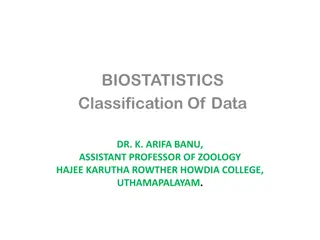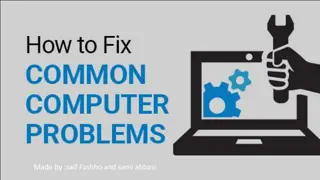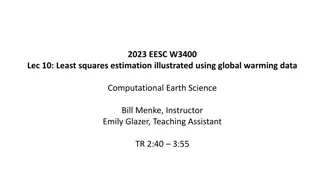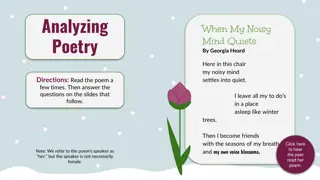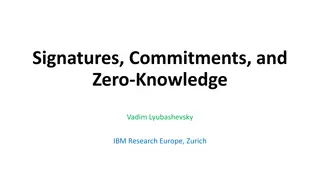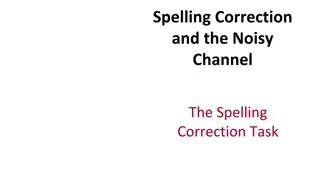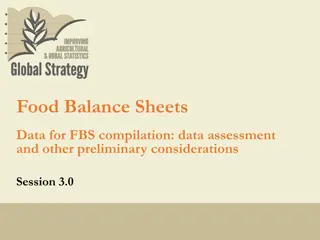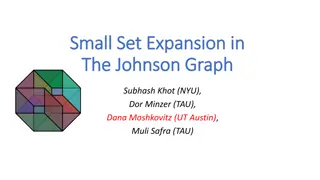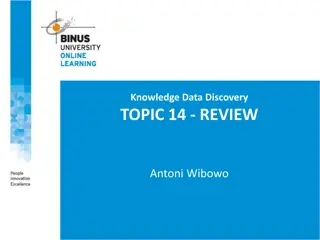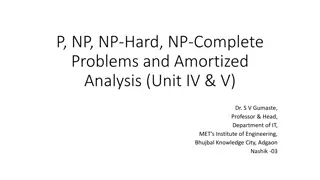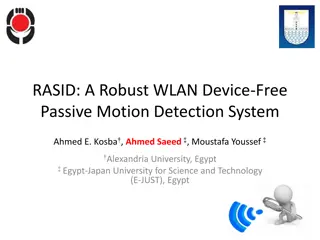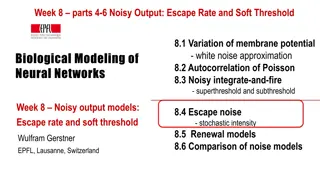Strategies for Dealing with Noisy Data in Classification Problems
Dealing with noisy data in classification problems is crucial for maintaining model performance. This challenge requires identifying noise, understanding its types, implementing noise filtering techniques, and using robust learners. Experimental comparative analysis helps in evaluating these strategies and their effectiveness. The presence of noise can significantly impact the accuracy of classifiers, making it essential to employ specialized techniques to mitigate its effects.
Download Presentation

Please find below an Image/Link to download the presentation.
The content on the website is provided AS IS for your information and personal use only. It may not be sold, licensed, or shared on other websites without obtaining consent from the author.If you encounter any issues during the download, it is possible that the publisher has removed the file from their server.
You are allowed to download the files provided on this website for personal or commercial use, subject to the condition that they are used lawfully. All files are the property of their respective owners.
The content on the website is provided AS IS for your information and personal use only. It may not be sold, licensed, or shared on other websites without obtaining consent from the author.
E N D
Presentation Transcript
Dealing with Noisy Data 1. Introduction 2. Identifying Noise 3. Types of Noise 4. Noise Filtering 5. Robust Learners Against Noise 6. Experimental Comparative Analysis
Dealing with Noisy Data 1. Introduction 2. Identifying Noise 3. Types of Noise 4. Noise Filtering 5. Robust Learners Against Noise 6. Experimental Comparative Analysis
Introduction The presence of noise in data is a common problem that produces several negative consequences in classification problems The performance of the models built under such circumstances will heavily depend on the quality of the training data Problems containing noise are complex problems and accurate solutions are often difficult to achieve without using specialized techniques
Dealing with Noisy Data 1. Introduction 2. Identifying Noise 3. Types of Noise 4. Noise Filtering 5. Robust Learners Against Noise 6. Experimental Comparative Analysis
Identifying Noise The presence of noise in the data may affect the intrinsic characteristics of a classification problem Noise may create small clusters of instances of a particular class in parts of the instance space corresponding to another class, remove instances located in key areas within a particular class, disrupt the boundaries of the classes and increase overlapping among them.
Identifying Noise Noise is specially relevant in supervised problems, where it alters the relationship between the informative features and the measure output For this reason noise has been specially studied in classification and regression Robustness is the capability of an algorithm to build models that are insensitive to data corruptions and suffer less from the impact of noise The more robust an algorithm is, the more similar the models built from clean and noisy data are
Identifying Noise Robustness is considered more important than performance results when dealing with noisy data it allows one to know a priori the expected behavior of a learning method against noise in cases where the characteristics of noise are unknown
Identifying Noise Several approaches have been studied in the literature to deal with noisy data: Robust learners. These are techniques characterized by being less influenced by noisy data. An example of a robust learner is the C4.5 algorithm Data polishing methods. Their aim is to correct noisy instances prior to training a learner Noise filters identify noisy instances which can be eliminated from the training data
Identifying Noise Noise is not the only problem that supervised ML techniques have to deal with. Complex and nonlinear boundaries between classes are problems that may hinder the performance of classifiers it often is hard to distinguish between such overlapping and the presence of noisy examples Relevant issues related to the degradation of performance: Presence of small disjuncts Overlapping between classes
Identifying Noise Another interesting problem is pointed out: the higher or lower presence of examples located in the area surrounding class boundaries, which are called borderline examples Misclassification often occurs near class boundaries where overlapping usually occurs Classifier performance degradation was strongly affected by the quantity of borderline examples the presence of other noisy examples located farther outside the overlapping region
Identifying Noise Safe examples are placed in relatively homogeneous areas with respect to the class label. Borderline examples are located in the area surrounding class boundaries, where either the minority and majority classes overlap or these examples are very close to the difficult shape of the boundary Noisy examples are individuals from one class occurring in the safe areas of the other class
Identifying Noise Safe examples are placed in relatively homogeneous areas with respect to the class label. Borderline examples are located in the area surrounding class boundaries, where either the minority and majority classes overlap or these examples are very close to the difficult shape of the boundary Noisy examples are individuals from one class occurring in the safe areas of the other class
Dealing with Noisy Data 1. Introduction 2. Identifying Noise 3. Types of Noise 4. Noise Filtering 5. Robust Learners Against Noise 6. Experimental Comparative Analysis
Types of Noise A large number of components determine the quality of a data set Among them, the class labels and the attribute values directly influence such a quality The quality of the class labels refers to whether the class of each example is correctly assigned the quality of the attributes refers to their capability of properly characterizing the examples for classification purposes
Types of Noise Based on these two information sources, two types of noise can be distinguished: Class noise (also referred as label noise) occurs when an example is incorrectly labeled. Two types of class noise can be distinguished: Contradictory examples Misclassifications Attribute noise refers to corruptions in the values of one or more attributes erroneous attribute values, missing or unknown attribute values, and incomplete attributes or do not care values
Types of Noise Attribute noise is more harmful than class noise Eliminating or correcting examples in data sets with class and attribute noise, respectively, may improve classifier performance Attribute noise is more harmful in those attributes highly correlated with the class labels Most of the works found in the literature are only focused on class noise
Noise Introduction Mechanisms Traditionally the label noise introduction mechanism has not attracted much attention However, the nature of noise becomes more and more important Authors distinguish between three possible statistical models for label noise
Noise Introduction Mechanisms a) In the most simplistic case in which the noise procedure is not dependent of either the true value of the class Y or the input attribute values X, the label noise is called noise completely at random or NCAR
Noise Introduction Mechanisms b) Things get more complicated in the noise at random (NAR) model. Although the noise is independent of the inputs X, the true value of the class make it more or less prone to be noisy. This asymmetric labeling error can be produced by the different cost of extracting the true class, as for example in medical case-control studies, financial score assets and so on
Noise Introduction Mechanisms The third and last noise model is the noisy not at random (NNAR), where the input attributes somehow affect the probability of the class label being erroneous. NNAR model is the more general case of class noise.
Noise Introduction Mechanisms In the case of attribute noise, the modelization described above can be extended and adapted: When the noise appearance does not depend either on the rest of the input features values or the class label the NCAR noise model applies When the attribute noise depends on the true value but not on the rest of input values or the observed class label y the NAR model is applicable In the last case (NNAR) the noise probability will depend on the value of the feature but also on the rest of the input feature values
Simulating the Noise of Real-World Data Sets Checking the effect of noisy data on the performance of classifier learning algorithms is necessary to improve their reliability and has motivated the study of how to generate and introduce noise into the data Noise generation can be characterized by three main characteristics: The place where the noise is introduced The noise distribution The magnitude of generated noise values
Simulating the Noise of Real-World Data Sets The two types of noise considered, class and attribute noise, have been modeled using four different noise schemes: Class noise is introduced using an uniform class noise scheme (randomly corrupting the class labels of the examples) and a pairwise class noise scheme (labeling examples of the majority class with the second majority class) Attribute noise is introduced using an uniform attribute noise scheme when erroneous attribute values can be totally unpredictable, and the Gaussian attribute noise scheme if noise is a low variation with respect to the correct value
Simulating the Noise of Real-World Data Sets Robustness compare the performance of the classifiers learned with the original (without induced noise) data set with the performance of the classifiers learned using the noisy data set Those classifiers learned from noisy data sets being more similar (in terms of results) to the noise free classifiers will be the most robust ones.
Dealing with Noisy Data 1. Introduction 2. Identifying Noise 3. Types of Noise 4. Noise Filtering 5. Robust Learners Against Noise 6. Experimental Comparative Analysis
Noise Filtering at Data Level Noise filters are preprocessing mechanisms to detect and eliminate noisy instances in the training set Result reduced training set which is used as an input to a classification algorithm The separation of noise detection and learning has the advantage that noisy instances do not influence the classifier building design
Noise Filtering at Data Level Noise filters are generally oriented to detect and eliminate instances with class noise from the training data Elimination of such instances has been shown to be advantageous The elimination of instances with attribute noise seems counterproductive Instances with attribute noise still contain valuable information in other attributes which can help to build the classifier It is also hard to distinguish between noisy examples and true exceptions
Noise Filtering at Data Level We will consider three noise filters designed to deal with mislabeled instances as they are the most common and the most recent It should be noted that these three methods are ensemble-based and vote-based filters. Collecting information from different models will provide a better method for detecting mislabeled instances than collecting information from a single model
Ensemble Filter The Ensemble Filter (EF) is a well-known filter in the literature It uses a set of learning algorithms to create classifiers in several subsets of the training data They serve as noise filters for the training set. The authors originally proposed the use of C4.5, 1-NN and LDA
Ensemble Filter The complete process carried out by EF is described below:
Cross-Validated Committees Filter The Cross-Validated Committees Filter (CVCF) is mainly based on performing an -FCV to split the full training data and on building classifiers using decision trees in each training subset The authors of CVCF place special emphasis on using ensembles of decision trees such as C4.5
Cross-Validated Committees Filter The basic steps of CVCF are the following:
Iterative-Partitioning Filter The Iterative-Partitioning Filter (IPF) is a preprocessing technique based on the Partitioning Filter IPF removes noisy instances in multiple iterations until the number of identified noisy instances in each of these iterations is less than a percentage p of the size of the original training data set
Iterative-Partitioning Filter The basic steps of each iteration are:
More Filtering Methods Apart from the three aforementioned filtering methods, we can find many more in the specialized literature Detection based on thresholding of a measure: Measure, Least complex correct hypothesis Classifier predictions based: Cost sensitive, SVM based, ANN based, Multi classifier system, C4.5 Voting filtering: Ensembles, Bagging, ORBoost, Edge analysis Model influence: LOOPC, Single perceptron perturbation Nearest neighbor based: CNN, BBNR, IB3, Tomek links, PRISM, DROP Graph connections based: Grabiel graphs, Neighborhood graphs
Dealing with Noisy Data 1. Introduction 2. Identifying Noise 3. Types of Noise 4. Noise Filtering 5. Robust Learners Against Noise 6. Experimental Comparative Analysis
Robust Learners Against Noise Filtering the data has also one major drawback: some instances will be dropped from the data sets, even if they are valuable We can use other approaches to diminish the effect of noise in the learned model One powerful approach is to train not a single classifier but several ones
Robust Learners Against Noise C4.5 has been considered as a paradigmatic robust learner against noise It is also true that classical decision trees have been considered sensitive to class noise as well Solutions: Carefully select an appropriate splitting criteria measure Prunning This instability has make them very suitable for ensemble methods
Robust Learners Against Noise An ensemble is a system where the base learners are all of the same type built to be as varied as possible Many ensemble approaches exist and their noise robustness has been tested The two most classic approaches are bagging and boosting Bagging obtains better performance than boosting when label noise is present When the base classifiers are different we talk of Multiple Classifier Systems (MCSs)
Robust Learners Against Noise We can separate the labeled instances in several bags or groups, each one containing only those instances belonging to the same class This type of decomposition is well suited for those classifiers that can only work with binary classification problems It has also been suggested that this decomposition can help to diminish the effects of noise This decomposition is expected to decrease the overlapping between the classes It limits the effect of noisy instances to their respective bags
Dealing with Noisy Data 1. Introduction 2. Identifying Noise 3. Types of Noise 4. Noise Filtering 5. Robust Learners Against Noise 6. Experimental Comparative Analysis
Experimental Comparative Analysis Summary of some major studies: Using filters diminish the loss of accuracy as the noise increases The complexity of the models obtained is also lower when using filters compared to no filtering at all The filtering efficacy depends on the characteristics of the data and can be anticipated Using MCSs improve the behavior of the classifier when compared to its parts (or base classifiers) Using a one-versus-one (OVO) decomposition improves the baseline classifiers in terms of accuracy when data is corrupted by noise in all the noise schemes shown
